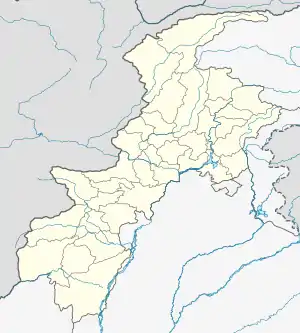Jamrud
Jamrūd (Pashto/Urdu: جمرود) or Jam (Pashto: جم) is a town in the Khyber District of Khyber Pakhtunkhwa, Pakistan. Located in the Valley of Peshawar, on the western fringe of Peshawar city, Jamrud is the doorway to the Khyber Pass which is just to the west of the town. The pass connects Jamrud with Landi Kotal to the west, located near the border of Afghanistan's Nangarhar Province.
Jamrud
جمرود Jam | |
|---|---|
Town | |
 Jamrud  Jamrud | |
| Coordinates: 34°00′N 71°23′E | |
| Country | |
| Region | |
| District | Khyber |
| Tehsil | Jamrud |
| Elevation | 1,512 ft (461 m) |
| Population | |
| • Total | 63,843 |
Jamrud has remained a location on the trade route between Central Asia and South Asia, and a strategic military location. It is located at an altitude of 461 metres (1,512 ft) above sea level. The Jamrud Fort is located 17 km (11 mi) west of the city of Peshawar.
History
The Battle of Jamrud between the Sikh Empire and Durrani Empire took place at Jamrud where the Sikh general Hari Singh Nalwa was wounded in the battle, Hari Singh Nalwa later succumbed to his injuries and the Sikh expansion was halted. Jamrud became the western most town of the Sikh Empire. The famous Jamrud Fort was also built in 54 days by Hari Singh Nalwa. The proposal to build the fort was issued to him by one of his generals. The proposal was opposed; however he finally decided to build the fort and construct its layout. The foundation of the fort that has survived was laid by General Hari Singh Nalwa on 18 December 1836 and the construction was completed in 54 days. The fort was finished on 10 February 1837. Hari Singh Nalwa's grave is still next to the fort where his cremated ashes remain. The fort of Jamrud was captured by the British Empire in 1849 after they annexed the Punjab region and ended the Sikh Empire. The British signed a treaty with Dost Mohammad Khan cementing British rule over the Khyber Pass. Jamrud was a strategic location and served as a base for a cantonment of the British Indian Army during the period of the British Raj. In 1857, the Second Anglo-Afghan Treaty was signed there. It was mainly used by the British army as a base of operations for their wars in Afghanistan. During the military operations of 1878-79 Jamrud became a place of considerable importance as the frontier outpost on British territory towards Afghanistan, and it was also the base of operations for a portion of the Tirah campaign in 1897-1898. It was also the headquarters of the Khyber Rifles, and the collecting station for the Khyber tolls. The place is currently now the headquarters of the Frontier Corps, a branch of the Pakistan Army. The population in 1901 was 1,848. In 2017, the population was recorded to be 63,843 and the place continues to be of strategic significance.

Notes
- "POPULATION AND HOUSEHOLD DETAIL FROM BLOCK TO DISTRICT LEVEL: FATA (KHYBER AGENCY)" (PDF). www.pbscensus.gov.pk. 3 January 2018. Archived from the original (PDF) on 2 April 2018. Retrieved 1 April 2018.
References
- Jamrūd - Imperial Gazetteer of India, v. 14, p. 52. http://dsal.uchicago.edu/reference/gazetteer/pager.html?objectid=DS405.1.I34_V14_058.gif
- North-West Frontier Province - Imperial Gazetteer of India, v. 19, p. 153. http://dsal.uchicago.edu/reference/gazetteer/pager.html?objectid=DS405.1.I34_V19_159.gif
- Gazetteer of the Peshawar District 1897-8, revised edition, Lahore: Punjab Government, p. 74.
- This article incorporates text from a publication now in the public domain: Chisholm, Hugh, ed. (1911). "Jamrud". Encyclopædia Britannica (11th ed.). Cambridge University Press.
- The Return of the King by William Dalrymple https://www.amazon.com/Return-King-Battle-Afghanistan-1839-42/dp/0307958280